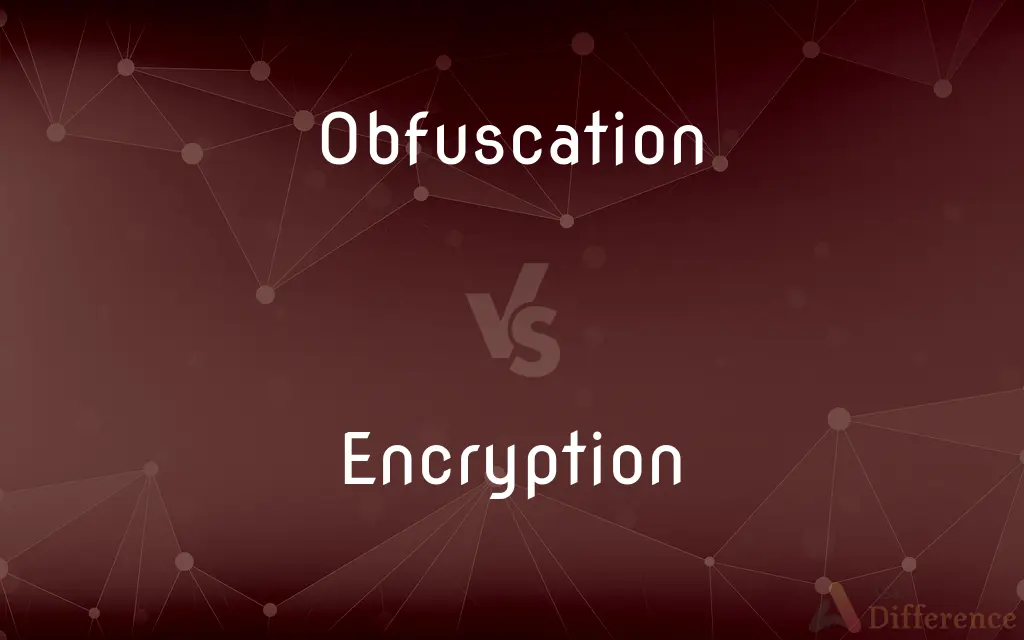Obfuscation vs. Encryption — What's the Difference?
Edited by Tayyaba Rehman — By Urooj Arif — Updated on March 21, 2024
Obfuscation is the process of making code or data difficult to understand, while encryption transforms data into a secure format that requires a key to decrypt.

Difference Between Obfuscation and Encryption
Table of Contents
ADVERTISEMENT
Key Differences
Obfuscation involves altering the appearance of code or data to make it harder to understand or interpret, often used to protect intellectual property in software by making it harder for others to reverse engineer. On the other hand, encryption is a security process that converts data into a coded format, readable only by those who possess the correct decryption key, primarily used to protect data confidentiality.
While obfuscation can deter casual observers or less determined attackers by making code or data less legible, it doesn't provide the mathematical security guarantees that encryption does. Encryption, through cryptographic algorithms, ensures that data remains secure and unreadable without the appropriate key, offering a high level of data protection against interception or unauthorized access.
Obfuscation techniques can vary from simple renaming of variables to complex algorithm transformations, and they do not generally alter the operational logic of the code or data. Conversely, encryption algorithms transform data in a way that significantly alters its format and appearance, making it incomprehensible without decryption.
In terms of application, obfuscation is widely used in software development to protect source code, whereas encryption is employed in a broader range of contexts, from securing online communications to protecting sensitive information stored on digital devices.
Although obfuscation can add a layer of security by obscurity, it is often recommended to be used in conjunction with more robust security measures like encryption, rather than as a standalone protection method. Encryption is considered a foundational element of data security strategies, essential for protecting data integrity and privacy.
ADVERTISEMENT
Comparison Chart
Purpose
To make code or data difficult to understand
To transform data into a secure format, requiring a key for decryption
Security Level
Low to moderate, relies on obscurity
High, based on cryptographic algorithms
Method
Altering appearance without changing fundamental functionality
Transforming data using mathematical algorithms
Key Requirement
No key required
Requires a key for decryption
Use Cases
Protecting software intellectual property
Protecting data confidentiality and integrity
Compare with Definitions
Obfuscation
Makes software code difficult to reverse engineer.
Obfuscating a mobile app's code to protect its proprietary algorithms.
Encryption
Ensures data can only be accessed by authorized parties.
Encrypting emails to protect sensitive information from unauthorized access.
Obfuscation
Increases effort required to understand or modify code.
Variable renaming and logic obfuscation can deter casual hackers.
Encryption
Provides strong security through mathematical algorithms.
AES encryption is used to secure online transactions.
Obfuscation
Does not use cryptographic keys for data transformation.
A script might be obfuscated automatically by a tool without needing a key.
Encryption
Used in various contexts to protect data integrity and privacy.
Encryption is fundamental in securing internet communications and data storage.
Obfuscation
Commonly used to protect intellectual property in code.
Companies obfuscate code before releasing commercial software to protect their work.
Encryption
Considered a cornerstone of modern data protection.
Encryption is mandated by many data protection regulations and standards.
Obfuscation
Often used alongside other security measures.
Obfuscation may be used with encryption to enhance data security.
Encryption
In cryptography, encryption is the process of encoding information. This process converts the original representation of the information, known as plaintext, into an alternative form known as ciphertext.
Obfuscation
Obfuscation is the obscuring of the intended meaning of communication by making the message difficult to understand, usually with confusing and ambiguous language. The obfuscation might be either unintentional or intentional (although intent usually is connoted), and is accomplished with circumlocution (talking around the subject), the use of jargon (technical language of a profession), and the use of an argot (ingroup language) of limited communicative value to outsiders.In expository writing, unintentional obfuscation usually occurs in draft documents, at the beginning of composition; such obfuscation is illuminated with critical thinking and editorial revision, either by the writer or by an editor.
Encryption
The process or result of encrypting data.
Obfuscation
To make so confused or opaque as to be difficult to perceive or understand
"A great effort was made ... to obscure or obfuscate the truth" (Robert Conquest).
Encryption
Cryptography.
Obfuscation
To render indistinct or dim; darken
The fog obfuscated the shore.
Encryption
(cryptography) The process of obscuring information to make it unreadable without special knowledge, key files, or passwords.
Obfuscation
(uncountable) The act or process of obfuscating, or obscuring the perception of something; the concept of concealing the meaning of a communication by making it more confusing and harder to interpret.
Encryption
(cryptography) A ciphertext, a cryptogram, an encrypted value. Usually used with the preposition "of" followed by the value that is hidden in it.
Obfuscation
The alteration of computer code to preserve its behavior while concealing its structure and intent.
You need to turn on obfuscation for these classes.
Encryption
The process of converting messages in ordinary language, or other information into a secret coded form that cannot be interpreted without knowing the secret method for interpretation, called the key.
Obfuscation
(uncountable) Confusion, bewilderment, or a baffled state resulting from something obfuscated, or made more opaque and muddled with the intent to obscure information.
Encryption
The activity of converting from plain text into code
Obfuscation
(countable) A single instance of intentionally obscuring the meaning of something to make it more difficult to grasp.
During the debate, the candidate sighed at his opponent's obfuscations.
Encryption
Data can only be decrypted with the correct key.
A secure messaging app might use keys to encrypt and decrypt messages.
Obfuscation
The act of darkening or bewildering; the state of being darkened.
Obfuscation
Confusion resulting from failure to understand
Obfuscation
The activity of obscuring people's understanding, leaving them baffled or bewildered
Obfuscation
Darkening or obscuring the sight of something
Common Curiosities
Is obfuscation the same as encryption?
No, obfuscation is about making code/data hard to read without altering its fundamental operation, while encryption mathematically transforms data into a secure format.
How does encryption protect data?
Encryption protects data by transforming it into a secure format that is unreadable without the appropriate decryption key, ensuring data confidentiality.
Why is a key necessary for encryption?
A key is necessary for encryption to allow authorized users to decrypt and access the original data while keeping it secure from unauthorized users.
What is the main goal of obfuscation?
The main goal of obfuscation is to make code or data difficult to understand to protect intellectual property or sensitive information.
Can obfuscation ensure data security on its own?
Obfuscation can deter some attackers, but it's not as secure as encryption and is best used as part of a broader security strategy.
Where is obfuscation commonly used?
Obfuscation is commonly used in software development to protect the source code from being easily reverse-engineered or copied.
Can encryption be broken without the key?
While theoretically possible with sufficient computational resources, breaking modern encryption without the key is impractical with current technology.
Is it possible to combine obfuscation and encryption?
Yes, combining obfuscation and encryption can provide an additional layer of security, especially in software applications.
What types of data are typically encrypted?
Sensitive information such as personal data, financial details, and confidential communications are typically encrypted for protection.
How effective is obfuscation against sophisticated attacks?
Obfuscation may not be effective against determined and sophisticated attackers, as it relies on security through obscurity.
How do organizations ensure the security of encryption keys?
Organizations use secure key management practices, including hardware security modules, access controls, and key rotation policies, to protect encryption keys.
Are there legal requirements for using encryption?
Yes, various laws and regulations require encryption for certain types of sensitive data, especially in industries like finance and healthcare.
What are the limitations of obfuscation?
The main limitation of obfuscation is that it doesn't change the underlying data or functionality, making it potentially reversible by skilled attackers.
How can one choose between obfuscation and encryption?
The choice depends on the specific needs: obfuscation for protecting intellectual property in software, and encryption for securing data against unauthorized access.
Can encryption slow down system performance?
Encryption can introduce some performance overhead, but modern algorithms and hardware optimizations minimize the impact.
Share Your Discovery

Previous Comparison
Animous vs. Animus
Next Comparison
Iris vs. IsisAuthor Spotlight
Written by
Urooj ArifUrooj is a skilled content writer at Ask Difference, known for her exceptional ability to simplify complex topics into engaging and informative content. With a passion for research and a flair for clear, concise writing, she consistently delivers articles that resonate with our diverse audience.
Edited by
Tayyaba RehmanTayyaba Rehman is a distinguished writer, currently serving as a primary contributor to askdifference.com. As a researcher in semantics and etymology, Tayyaba's passion for the complexity of languages and their distinctions has found a perfect home on the platform. Tayyaba delves into the intricacies of language, distinguishing between commonly confused words and phrases, thereby providing clarity for readers worldwide.














































